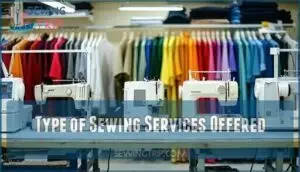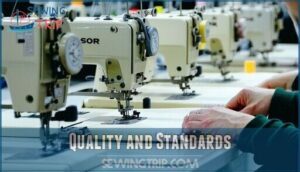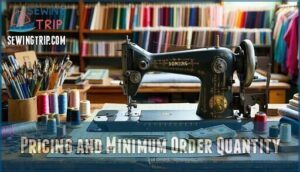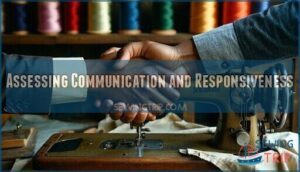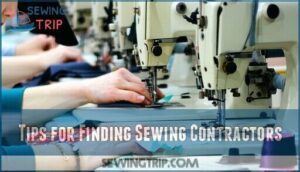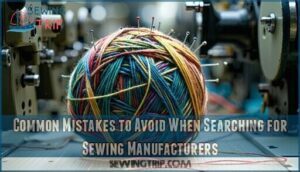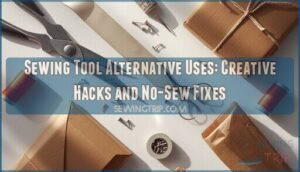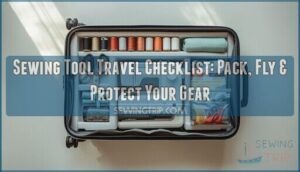This site is supported by our readers. We may earn a commission, at no cost to you, if you purchase through links.
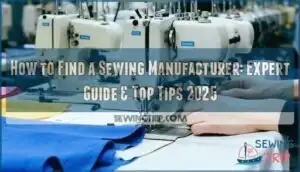
You’ll want to start with online directories like Maker’s Row, Sourcify, and Alibaba to browse potential partners.
Trade shows offer hands-on opportunities to meet manufacturers and assess their capabilities firsthand.
Industry associations provide vetted networks of reliable producers.
When evaluating options, consider their specialties, production capacity, quality standards, and minimum order requirements.
Don’t forget to request samples and check references before committing.
Whether you choose domestic or overseas manufacturing depends on your budget, timeline, and quality needs.
The key lies in building relationships built on clear communication and shared goals rather than just chasing the lowest price.
Table Of Contents
- Key Takeaways
- Where to Find Sewing Manufacturers
- What to Consider When Choosing a Sewing Manufacturer
- How to Vet and Evaluate Sewing Manufacturers
- Domestic Vs. Overseas Sewing Manufacturers
- Best Practices for Building a Strong Relationship With a Sewing Manufacturer
- Tips for Finding Sewing Contractors
- Common Mistakes to Avoid When Searching for Sewing Manufacturers
- Frequently Asked Questions (FAQs)
- Conclusion
Key Takeaways
- Research multiple channels – You’ll find quality manufacturers through online directories like Maker’s Row, trade shows, and industry associations rather than relying on a single source.
- Prioritize quality over price – You cannot afford to choose manufacturers based solely on the lowest quotes, since hidden costs, defects, and rework will damage your reputation and profitability.
- Test communication early – You’ll need manufacturers who respond within 24-48 hours and provide clear, detailed answers, since poor communication leads to production delays and costly misunderstandings.
- Build long-term partnerships – You should focus on manufacturers who can scale with your business and share your quality standards, rather than treating them as one-time vendors.
Where to Find Sewing Manufacturers
Finding the right sewing manufacturer doesn’t have to feel overwhelming when you know where to look.
You’ll discover quality partners through online directories, trade shows, and industry networks that match your specific production needs.
This approach allows you to find manufacturers that meet your specific production requirements, ensuring a successful partnership.
Online Directories
Online directories offer the fastest path to finding qualified sewing manufacturers.
Start with Maker’s Row, which connects over 250,000 brands with vetted factories using advanced search filters.
ThomasNet provides extensive clothing manufacturer listings with strong directory credibility.
Use niche directories for specialized needs and verify review authenticity before contacting suppliers.
Paid listings often indicate serious manufacturers committed to quality partnerships.
For a thorough overview, consider exploring a clothing manufacturers directory to expand your search and find the best quality partnerships.
Trade Shows and Exhibitions
Trade shows offer unparalleled opportunities for trade show networking with sewing manufacturers face-to-face. You’ll find major fashion trade shows like MAGIC trade show and Sourcing at Magic bringing together hundreds of suppliers under one roof.
This beats scrolling through online directories endlessly, and at these events, you can assess exhibition booth design quality, examine fabric samples, and gauge professionalism instantly.
Show budget planning becomes essential since attending multiple events adds up quickly. However, the investment pays off through direct competitor analysis and trend forecasting insights.
Trade shows let you compare manufacturers side-by-side, negotiate terms on the spot, and build relationships that online interactions can’t match. You’ll discover new technologies and innovations while connecting with decision-makers who actually have authority to negotiate pricing and minimums.
These events are also pivotal for discovering emerging trends in the fashion industry, allowing for valuable connections and industry insights.
Industry Associations and Networks
Industry associations open doors to valuable manufacturing connections you won’t find elsewhere.
The CFDA offers exclusive benefits and networking events where you’ll meet vetted suppliers.
Local chapters provide mentorship programs and industry standards guidance.
Online communities on platforms like Maker’s Row connect you with 20,000+ manufacturers, often leading to partnerships with higher trust levels than cold outreach alone.
What to Consider When Choosing a Sewing Manufacturer
Once you’ve found potential sewing manufacturers, you’ll need to evaluate them carefully to verify they’re the right fit for your project.
The key factors to examine include their service offerings, production capabilities, quality standards, and pricing structure.
Type of Sewing Services Offered
Understanding the different types of sewing services helps you find the right manufacturing partner for your project.
Each sewing manufacturer offers varying service levels that match different business needs.
Consider these key service categories when evaluating potential partners:
- Manufacturing Models – CMT (Cut, Make, Trim), FPP (Full Package Production), ODM (Original Design Manufacturing), or OEM (Original Equipment Manufacturing) services
- Specialization Alignment – Expertise in your specific garment types like activewear, formal wear, or technical textiles
- Production Scope – In-house capabilities versus outsourced steps for pattern making, cutting, dyeing, or finishing
- Sewing Contractor Capabilities – Quality control systems, certifications, and testing procedures that guarantee consistent results
Matching your requirements with a sewing contractor’s specialization creates better outcomes than choosing generalist clothing manufacturers.
Production Capacity and Lead Time
Production capacity and lead times directly impact your ability to meet customer demand and scale your business.
When evaluating manufacturers, ask specific questions about their daily output, current workload, and ability to handle rush orders. Look for partners who can accommodate your growth trajectory without compromising quality or extending delivery timelines beyond market expectations.
| Factor | Questions to Ask |
|---|---|
| Production Capacity | How many units can you produce daily? What’s your current capacity utilization? |
| Lead Time Reduction | What’s your standard lead time? Can you expedite orders when needed? |
| Scaling Production | How do you handle increased order volumes? What’s your maximum production capacity? |
| Production Bottlenecks | What factors typically cause delays? How do you manage supply chain disruptions?." |
Smart manufacturers will provide transparent answers about their capacity planning and forecasting demand processes.
They’ll also discuss their approach to small batch sewing and MOQ requirements, helping you understand how they balance efficiency with flexibility for growing brands.
Quality and Standards
Quality standards determine whether your manufacturer delivers professional results or disappointing failures. You’ll want partners who maintain strict quality control throughout production and hold recognized certifications.
- Material Consistency – Verify fabrics meet specifications for strength, colorfastness, and shrinkage before production begins
- Stitching Techniques – Look for precise seam construction and thread quality that guarantees garment longevity
- Durability Testing – Confirm manufacturers test products for wear resistance and structural integrity
- Ethical Production – Choose partners with SA8000 or WRAP certifications for fair labor practices
- Certification Importance – Prioritize ISO 9001 and OEKO-TEX certified facilities for quality assurance standards
Pricing and Minimum Order Quantity
Pricing structures and minimum order quantities can make or break your manufacturing partnership.
Compare per unit costs across different order quantities to understand bulk discounts and cost breakdowns.
Most manufacturers offer MOQ flexibility for established clients, so discuss pricing negotiation options upfront.
Don’t forget to clarify payment terms and factor in additional costs like shipping, duties, and sampling fees when evaluating your total investment.
How to Vet and Evaluate Sewing Manufacturers
Once you’ve identified potential manufacturers, you’ll need to carefully evaluate them to verify they meet your quality standards and business needs.
This vetting process involves three key steps: requesting samples and portfolios, visiting manufacturing facilities, and evaluating their communication skills and responsiveness.
Requesting Samples and Portfolio
Before committing to any manufacturer, you’ll want to see their work firsthand.
Sample quality tells you everything about a manufacturer’s capabilities and attention to detail.
- Request garment samples that match your product type to assess construction details and design accuracy
- Review their complete portfolio to evaluate material sourcing options and past project quality
- Test supplier responsiveness by asking specific questions about sample production timelines and quality control processes
Don’t settle for photos alone – physical samples reveal manufacturer quality that pictures can’t capture.
Many businesses use a garment samples request to streamline this process.
Pay attention to stitching consistency, fabric handling, and finishing techniques during your portfolio assessment.
Visiting The Manufacturing Facility
Nothing beats seeing a facility firsthand to assess Factory Legitimacy and Working Conditions.
Schedule factory tours to evaluate Production Capabilities, inspect equipment, and observe Quality Control processes.
If visiting isn’t possible, hire a third-party factory audit service for clothing factory inspection.
A thorough factory assessment can provide valuable insights.
Sample Inspection during your visit reveals the true quality of their production facilities and manufacturing standards.
Assessing Communication and Responsiveness
Communication frequency matters more than you might think.
Manufacturers who respond within 24-48 hours show professional standards.
Test response timeliness during initial inquiries to gauge their commitment.
Language barriers can create costly miscommunication, so prioritize clear communication over low prices.
Ask how they handle feedback integration and cultural differences.
Understanding the nuances of sewing manufacturer responsiveness is vital for a successful partnership.
Strong manufacturer communication prevents delays and guarantees your vision becomes reality.
Domestic Vs. Overseas Sewing Manufacturers
When choosing between domestic and overseas sewing manufacturers, you’ll face a critical decision that affects your product quality, costs, and timeline.
Each option offers distinct advantages and challenges that can substantially impact your business success.
Pros and Cons of Domestic Manufacturing
After evaluating potential manufacturers, you’ll need to choose between domestic and overseas production.
Domestic manufacturing offers significant advantages for quality control and communication ease. USA clothing manufacturers provide better oversight and faster turnaround times.
| Aspect | Advantages | Disadvantages |
|---|---|---|
| Quality Assurance | Real-time oversight, stricter standards | Higher production costs |
| Communication | Same time zones, shared language | Limited production capacity |
| Ethical Labor | Regulated working conditions | Smaller facility options |
| Brand Perception | "Made in USA" premium appeal | Higher minimum order quantities |
Domestic manufacturing delivers superior quality control through proximity and shared standards. However, you’ll pay premium prices for ethical clothing production and face higher minimums than overseas alternatives.
Pros and Cons of Overseas Manufacturing
When weighing overseas manufacturing, you’ll find significant cost savings but face real trade-offs.
Labor costs can drop from $15-50 per unit domestically to just $3 overseas, creating substantial savings for large orders.
However, quality control becomes challenging without direct oversight, and communication barriers can complicate problem-solving.
Modern factories use automated cutting machines to enhance precision and speed.
| Advantages | Disadvantages | Key Considerations |
|---|---|---|
| Labor costs as low as $3/unit | Quality control challenges | Import duties add $0.50-$10/unit |
| High-volume production capacity | Extended lead times (weeks) | Communication barriers exist |
| Access to specialized skills | Ethical concerns with labor | Shipping delays are common |
Import duties and shipping times can erode initial cost savings, while ethical concerns about working conditions require careful vetting of potential partners.
Factors to Consider When Making a Decision
Now that you’ve compared domestic and overseas options, selecting the right sewing manufacturer requires careful analysis of several key factors.
Service alignment tops the list—your chosen garment factory must specialize in your specific product type. Production capacity directly impacts your timeline, while quality standards determine your brand’s reputation.
| Factor | Domestic Impact | Overseas Impact |
|---|---|---|
| Lead Times | 2-4 weeks faster | 6-12 weeks longer |
| Communication | Real-time responses | Time zone delays |
| Quality Control | Direct oversight | Third-party inspection |
| Minimum Orders | Lower quantities | Higher volume required |
| Total Costs | Higher labor, lower shipping | Lower labor, higher duties |
Your pricing structure analysis should include hidden costs like import duties and shipping delays. Communication style matters—you’ll need responsive partners who understand your vision and can adapt to changes quickly.
Best Practices for Building a Strong Relationship With a Sewing Manufacturer
Finding the right sewing manufacturer is only the first step—building a strong partnership guarantees your production runs smoothly and your business thrives.
You’ll need to establish clear communication, provide regular feedback, and work together to solve problems that arise during the manufacturing process.
Clear Communication and Expectations
Setting clear expectations from the outset prevents costly misunderstandings and project delays. You’ll need detailed tech pack clarity that covers materials, measurements, and construction methods.
Active listening during initial discussions helps identify potential issues early. Your feedback frequency should match production milestones to maintain quality control. Cultural sensitivity matters when working with international manufacturers.
- Define exact specifications in your tech pack before production begins
- Establish regular check-in schedules for project updates and reviews
- Create written agreements that outline quality standards and delivery timelines
- Ask clarifying questions when instructions seem unclear or incomplete
- Document all changes and approvals to maintain accurate project records
Setting clear expectations and following these steps will help ensure a successful project outcome, with a focus on clear expectations and regular check-ins to prevent issues and maintain a high level of quality throughout the production process.
Regular and Transparent Feedback
Building trust through regular feedback keeps your partnership strong and your products improving.
Schedule quality control checkpoints throughout production to catch issues early. Provide constructive criticism alongside praise when reviewing samples or finished goods.
Open communication about addressing concerns prevents small problems from becoming major headaches. Focus on performance improvement rather than blame when discussing quality issues.
This feedback frequency creates a collaborative environment where both parties work toward better results, emphasizing the importance of regular feedback and open communication to build a strong partnership.
Collaboration and Problem-Solving
When challenges arise, approach them as partners working toward shared goals rather than adversaries.
Open communication creates the foundation for effective conflict resolution and proactive solutions.
Here’s how to foster strong collaboration:
- Address issues immediately – Don’t let problems fester or compound over time
- Brainstorm solutions together – Combine your market knowledge with their manufacturing expertise
- Maintain mutual respect – Value their input and experience in problem-solving discussions
- Document agreements – Keep clear records of decisions and action plans
This collaborative approach transforms obstacles into opportunities that strengthen your business relationship and improve future outcomes.
Long-Term Partnership Opportunities
Through strategic alignment and open communication, you’ll discover that longterm partnerships with manufacturers create mutual growth opportunities.
When you establish shared goals and maintain consistent quality standards, both parties benefit from this collaboration.
Clear communication becomes the foundation for effective problemsolving and builds trust over time.
This winwin setup transforms your manufacturer from a simple vendor into a valuable business ally who’s invested in your success.
Tips for Finding Sewing Contractors
Finding sewing contractors requires strategic research across multiple channels to connect with quality manufacturers.
You’ll need to explore online platforms, leverage local networks, and tap into industry communities to identify contractors who match your specific production needs.
Online Directories and Platforms
Online directories simplify finding sewing contractors by connecting you with thousands of verified manufacturers worldwide.
Platforms like Maker’s Row and Thomasnet offer search filters to match your specific needs, while user reviews help assess reliability.
Directory accuracy varies, so verify listings through samples and direct communication before committing to partnerships with reliable manufacturers, ensuring reliability through thorough assessment.
Local Sewing and Fabric Stores
Your neighborhood fabric stores hold hidden connections to skilled sewing contractors who often work behind the scenes.
Store owners frequently know local tailors who handle custom projects and repair services beyond basic fabric selection. These professionals understand your area’s sewing community and can recommend contractors based on your specific needs. Modern shops also offer online support options for customer convenience.
Here are five ways to leverage local sewing and fabric stores:
- Ask store owners directly – They often maintain lists of trusted sewing contractors for customer referrals
- Check bulletin boards – Many stores display business cards from local sewing services and custom project specialists
- Attend sewing classes – Connect with experienced sewers who may offer contractor services or know reliable professionals
- Visit during peak hours – You’ll meet other customers who might share recommendations for quality sewing contractors
- Build relationships with staff – Regular visits help staff understand your needs and match you with appropriate local sewing services
Networking and Referrals
Your best manufacturing leads come from people who’ve walked the path before you.
Reach out to fellow entrepreneurs on LinkedIn and ask for referrals from their trusted sewing contractors.
Industry connections through networking events and online communities provide invaluable insights you can’t get from Google searches alone.
Online Communities and Forums
Beyond personal networking, online communities offer valuable insider knowledge for finding quality sewing contractors.
Fashion startup forums and Facebook groups provide real-world experiences from other entrepreneurs who’ve worked with manufacturers.
- Niche forum selection helps you find specialized communities focused on your specific garment type
- Active participation benefits include access to exclusive supplier recommendations and pricing insights
- Community vetting process allows you to verify manufacturer reliability through peer reviews
- Forum etiquette rules guarantee respectful networking that builds lasting professional relationships
Common Mistakes to Avoid When Searching for Sewing Manufacturers
Finding the right sewing manufacturer requires careful evaluation beyond just getting the lowest quote.
Many businesses make critical errors that cost them time, money, and quality by rushing the selection process or focusing on the wrong factors.
Relying Solely on Price Comparison
Price comparison shopping might seem smart, but it’s a trap that catches many manufacturers off guard.
You’ll face quality compromises when chasing the lowest bid, turning those initial cost savings into expensive headaches. Hidden costs pile up through rework, delays, and customer complaints that damage your reputation.
Smart manufacturers dig deeper than surface-level pricing. They examine long-term value, sustainable practices, and ethical concerns before signing contracts. One key consideration is ignoring time and labor, which can substantially impact profitability.
Here’s what really matters when evaluating production cost:
| Price-Only Focus | Quality-First Approach | Long-Term Impact |
|---|---|---|
| Cheapest bid wins | Samples and references checked | Sustainable growth |
| Hidden fees emerge | Transparent bulk production cost | Predictable expenses |
| Quality disasters | Ethical manufacturing verified | Brand reputation protected |
| Constant rework | Consistent output delivered | Customer satisfaction |
| Broken partnerships | Trust-based relationships | Reliable supply chain |
Your reputation depends on consistent quality, not rock-bottom pricing.
Neglecting Quality and Standards
Quality standards aren’t optional when building your brand reputation. You can’t afford defects reaching customers or compromising ethical production practices.
Verify manufacturers maintain proper quality control systems and standard compliance before partnering:
- Request ISO certifications and industry standards documentation
- Review defect prevention procedures and testing protocols
- Inspect quality control checkpoints throughout production stages
- Confirm compliance with safety regulations and ethical standards
Quality control protects your investment and customer trust.
Overlooking Communication and Responsiveness
Communication serves as the backbone of successful manufacturing partnerships. You can’t afford to partner with manufacturers who respond slowly or provide vague answers to your questions.
Poor communication leads to production delays, quality issues, and costly misunderstandings that derail your timeline.
| Communication Warning Signs | Impact on Your Project | What to Look For Instead |
|---|---|---|
| Delayed email responses | Missed deadlines | Same-day replies to urgent questions |
| Vague project updates | Uncertainty about progress | Detailed status reports with timelines |
| Unclear pricing quotes | Budget overruns | Itemized costs with explanation |
Test responsiveness during initial conversations. Ask specific questions about their processes and evaluate how thoroughly they answer. Manufacturers who provide clear communication from the start will maintain that standard throughout production.
Establish feedback frequency expectations early to guarantee smooth collaboration and quick resolutions when issues arise.
Not Considering Long-Term Partnership Potential
Many brands focus solely on price comparison and MOQ without considering whether their sewing manufacturer can support long-term growth.
This shortsighted approach limits your business potential and creates unnecessary risks down the road.
Consider these partnership factors:
- Mutual Growth – Does the clothing manufacturer invest in expanding capabilities alongside your business?
- Shared Goals – Are they committed to quality improvements and ethical practices?
- Strategic Alignment – Can the clothing factory adapt to your evolving product lines?
- Collaborative Innovation – Will they work with you on design improvements and cost optimization?
- Trust Building – Do they demonstrate reliability through consistent communication and delivery?
Frequently Asked Questions (FAQs)
How to find out where a brand is manufactured?
Playing detective to uncover manufacturing secrets requires some sleuthing skills.
Check product labels for "Made in" locations, contact customer service directly, search company websites for transparency pages, or look up manufacturing partnerships in trade publications and industry databases to find the necessary information for uncovering secrets.
How to find a manufacturer to create your product?
Start by defining your product requirements and budget.
Research manufacturers using online directories like Maker’s Row, Alibaba, and industry trade shows.
Request samples, verify credentials, and compare pricing before finalizing partnerships, ensuring you have found the right manufacturers.
How to find sewing contracts?
Search online directories like Maker’s Row and Thomasnet.com, which lists over 440 sewing contractors nationwide.
Attend trade shows, check industry associations, and seek referrals from other businesses for reliable contract manufacturers.
What is the app that finds clothing manufacturers?
Among 440+ U.S. sewing contractors, Maker’s Row stands out as the leading app for finding clothing manufacturers.
You’ll filter by location, specialty, and services while accessing verified supplier profiles with ratings and reviews.
What payment terms do manufacturers typically require?
Manufacturers typically require 30-50% deposits upfront, with the balance due upon completion or shipment.
You’ll encounter terms like net 30, letter of credit, or full payment before production starts, depending on your relationship and order size, which may include a letter of credit.
How do I protect my design IP?
Use non-disclosure agreements (NDAs) before sharing designs, register trademarks for brand elements, and consider design patents for unique features.
Choose manufacturers with strong IP protection policies and established reputations for confidentiality.
What certifications should manufacturers have for compliance?
Look for ISO 9001:2015 for quality management, AS9100D for aerospace applications, and ISO 14001 for environmental standards.
You’ll also want OEKO-TEX certifications for textile safety and social compliance audits like WRAP or BSCI.
How do I handle defective products returns?
Establish clear return policies in your manufacturing contract before production begins.
Document defects thoroughly with photos and work directly with your manufacturer to determine if issues stem from materials, production, or design flaws for proper resolution.
What backup plans exist for production delays?
Production hiccups don’t spell disaster when you’ve got contingency plans ready.
Diversify suppliers across multiple manufacturers, maintain buffer inventory, negotiate flexible payment terms, establish clear penalty clauses.
Develop relationships with backup contractors for seamless handovers.
Conclusion
Finding success with how to find a sewing manufacturer requires patience versus rushing into partnerships.
You’ve learned the essential steps to locate, evaluate, and partner with manufacturers who match your needs.
Remember to prioritize quality standards and clear communication over lowest prices.
Don’t skip sample requests or reference checks during your search process.
Building strong relationships takes time, but the right manufacturer becomes your competitive advantage in today’s market.
- https://fourthwall.com/blog/how-to-find-quality-clothing-manufacturers-for-your-startup
- https://ajgfashionconsulting.com/blog/tips-and-tricks-for-finding-a-trustworthy-clothing-manufacturer
- https://wonnda.com/magazine/source-clothing-manufacturers/
- https://www.uphance.com/blog/cut-and-sew-manufacturing/
- https://successfulfashiondesigner.com/how-to-find-a-clothing-manufacturer/

